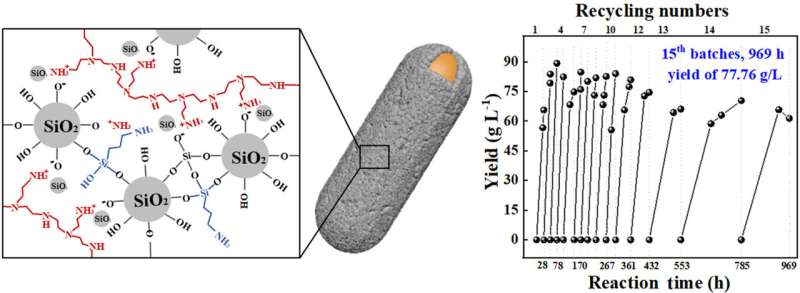This article has been reviewed according to Science X's editorial process and policies. Editors have highlighted the following attributes while ensuring the content's credibility:
fact-checked
proofread
Permeable and robust polymer-silica hybrid armor on cell catalyst for sustainable biomanufacturing

Whole-cell catalysis is one of the several central techniques in green biomanufacturing, which can be categorized into living cell catalysis, resting cell catalysis, and inactivated cell catalysis. Among these, inactivated cell catalysis features the benefits of low-cost and simple purification of products. However, the instability and leakage of enzymes in inactivated cells restrict the practical applications of inactivated cell catalysis.
Constructing armors on the surface of inactivated cells affords a feasible and effective strategy to enhance the enzyme stability and inhibit enzyme leakage. Silica armor (SA) features low-cost, controllable structure and food safety compliance, holding great potential in cell immobilization for producing high value-added chemicals. Nevertheless, thicker SA exhibits higher strength and lower permeability, while thinner SA shows the opposite. Therefore, permeable and robust SA on cell catalysts is highly demanded.
Herein, a polymer-silica hybrid armor (PSHA) is constructed on the surface of cells through polyethyleneimine (PEI)-induced hydrolysis and condensation of tetraethoxysilane (TEOS) and 3-aminopropyltriethoxysilane (APTES) by a team of researchers from Tianjin University. Due to the branched structure, PEI can help generate nanopores in the disordered SA, enhancing the permeability. Meanwhile, the multiple interactions such as hydrogen bonding (N···H or O···H) and electrostatic interactions (NH3+ with O-) between PEI and SA can enhance the mechanical strength of the armor.
The team of researchers from Tianjin University published their work in the journal Particuology.
The team tested the permeability and mechanical strength of PSHA, the cells, cell@SA, and cell@PSHA. The specific surface area of cell@PSHA was 5.93 times that of cells and 1.92 times that of cell@SA. The total pore volume of cell@PSHA was 3.82 times that of cells and 1.45 times that of cell@SA and the diffusion rate of MD spreading through PSHA was higher than SA. PSHA had higher permeability than SA.
Furthermore, the Young's modulus of cell@PSHA could be as high as 2.69±1.28 GPa, while the Young's modulus of cells and cell@SA were 0.42±0.08 GPa and 0.86±0.26 GPa, respectively. By contrast, PSHA possessed higher mechanical strength.
The team tested the effects of PEI in PSHA. With the concentration of PEI increased, the diffusion rate of MD through PSHA was further enhanced. With the increase of PEI concentration, the half-life of cell@PSHA was significantly prolonged. The half-life of cell@PSHA prepared by 0.75 g L-1 PEI was 94.95 h, while the half-life of cell@PSHA prepared by 0.05 g L-1 PEI was only 34.49 h. the permeability and mechanical strength of PSHA was further enhanced, which prove the importance of PEI in PSHA.
The team tested the application of cell@PSHA in tagatose production. The activity of cell@PSHA was higher than cell@SA and it might be attributed to the exceptional permeability and favorable bio-compatibility of PSHA. The thermal stability of cell@PSHA had been significantly improved and the half-life of cell@PSHA was extended by 216.18% and 175.38% comparing with cells and cell@SA.
In addition, industrial application potential of cell@PSHA was evaluated. Cell@PSHA could catalyze 15 consecutive reactions over 969 h while cell@SA could catalyze 7 consecutive reactions, indicating better reuse effect of cell@PSHA than cell@SA. In 15 batches of reactions, the tagatose yield of cell@PSHA was all higher than 60 g L-1, and the average yield could reach 77.76 g L-1.
The team members are Yiran Cheng, Zhenhua Wu, Boyu Zhang, Jiaxu Zhang, Jiafu Shi, Zhongyi Jiang from Tianjin University, China.
More information: Yiran Cheng et al, Permeable and robust polymer-silica hybrid armor on cell catalyst for sustainable biomanufacturing, Particuology (2024). DOI: 10.1016/j.partic.2024.05.002
Provided by Particuology




















